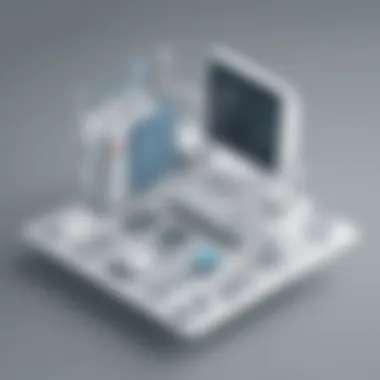Comprehensive Guide to Exploring Facets Healthcare Software for Enhanced Operations and Patient Care


Software Overview
Facets healthcare software is a powerful tool designed to revolutionize healthcare management and improve patient outcomes. With a wide array of features and functionalities, this software offers comprehensive solutions for healthcare professionals and IT experts in streamlining operations and enhancing patient care. The pricing plans and available subscriptions cater to different needs within the industry, ensuring scalability and flexibility.
User Experience
The user interface of Facets healthcare software is intuitive and user-friendly, providing easy navigation through its various modules and functions. Its design focuses on simplifying complex workflows, reducing the learning curve for new users, and increasing overall efficiency. Customer support options are robust, offering reliable assistance in case of any queries or technical issues.
Performance and Reliability
Facets software exhibits exceptional speed and efficiency in handling healthcare-related tasks, ensuring seamless operations and minimal downtime. Its uptime statistics are impressive, contributing to uninterrupted service delivery. The software also boasts strong integration capabilities with other tools, allowing for seamless data exchange and interoperability.
Security and Compliance
Data encryption and robust security protocols are paramount features of Facets healthcare software, ensuring the protection of sensitive patient information and adherence to strict confidentiality standards. The software is fully compliant with industry regulations, guaranteeing data privacy and security. Moreover, it incorporates reliable backup and disaster recovery measures to prevent data loss and ensure continuity of operations.
Introduction to Facets Healthcare Software
Facets Healthcare Software is a paramount subject in our exploration, shedding light on its intricate features, benefits, and practical applications within the healthcare industry. By dissecting the nuances of this software, we aim to offer healthcare professionals and IT experts valuable insights into how Facets can enhance operational efficiencies and boost patient care standards through technological advancement.
Understanding the Basics
Overview of healthcare software landscape
When examining the landscape of healthcare software, we uncover a dynamic ecosystem designed to streamline processes, enhance communication, and improve patient care. Within this intricate web of technologies, Facets software emerges as a pivotal player, providing robust solutions tailored to the evolving healthcare demands. Its intuitive interface and comprehensive features position Facets as a preferred choice for organizations seeking operational excellence and patient-centric care. Despite its complexities, the user-friendly design of Facets ensures a seamless integration into existing healthcare systems.
Evolution of Facets software
The evolution of Facets software signifies a transformative journey marked by innovation and adaptability. From its inception to the present day, Facets has continuously evolved to meet the ever-changing needs of the healthcare landscape. Its agile development cycle and proactive approach to industry trends have cemented its reputation as a reliable and forward-thinking software solution. The emphasis on scalability and customization further distinguishes Facets from its counterparts, allowing users to tailor the software to their specific requirements while maintaining optimal performance.
Key Features and Functionality


Claims processing
Within Facets software, the claims processing module stands out as a cornerstone of efficient revenue cycle management. By automating claim submission, adjudication, and payment processes, Facets streamlines financial operations and reduces manual errors. The real-time analytics embedded within the claims processing module empower organizations to track and analyze reimbursement trends, ensuring timely payments and revenue optimization.
Member management
Facets excels in member management by centralizing and analyzing patient data to facilitate personalized care plans and improve health outcomes. The platform's comprehensive member profiles enable healthcare providers to proactively engage with patients, leading to better care coordination and treatment adherence. With robust security features to safeguard sensitive information, Facets ensures data confidentiality while enabling seamless data sharing among authorized users.
Provider network integration
The seamless integration of provider networks within Facets software fosters collaboration and enhances care coordination across healthcare settings. By connecting healthcare professionals, facilities, and services on a unified platform, Facets optimizes resource allocation and ensures timely access to quality care for patients. The interoperability features embedded in the provider network integration module not only streamline administrative processes but also promote continuity of care for improved patient outcomes.
Benefits of Implementing Facets Software
Improved efficiency and accuracy
The implementation of Facets software yields tangible benefits in terms of operational efficiency and data accuracy. By automating manual tasks and minimizing redundant processes, Facets accelerates workflow cycles and reduces the likelihood of errors. The machine-learning capabilities incorporated within Facets enhance decision-making accuracy, empowering healthcare professionals to make informed clinical and administrative decisions in real time.
Enhanced patient experience
Through its patient-centric design and advanced functionalities, Facets elevates the overall patient experience within healthcare settings. The intuitive user interface and personalized care features engage patients in their health journey, fostering a sense of empowerment and collaboration. By promoting transparent communication and shared decision-making, Facets cultivates a culture of patient-centered care that prioritizes individual needs and preferences.
Cost-effectiveness
From a financial perspective, the implementation of Facets software proves cost-effective by reducing operational overheads and optimizing resource utilization. The automation capabilities of Facets minimize manual intervention, leading to increased productivity and cost savings. Moreover, the predictive analytics tools embedded within Facets enable proactive cost management strategies, allowing organizations to forecast expenses and allocate resources judiciously for long-term sustainability.
Applications in Healthcare Settings
In this article, the focus shifts towards exploring the applications of Facets Healthcare Software within healthcare settings. The importance of this topic lies in the pivotal role that healthcare software plays in optimizing operations and enhancing patient care quality. By delving into specific elements such as streamlining administrative processes, enhancing billing procedures, optimizing claims management, ensuring regulatory compliance, simplifying appointment scheduling, and improving patient data security, a holistic view of how Facets Software can benefit different facets of the healthcare industry emerges.
Hospital Management


Streamlining Administrative Processes
Streamlining administrative processes is a crucial aspect of hospital management addressed in this article. This function contributes significantly to the overall efficiency and effectiveness of healthcare facilities. The key characteristic of streamlining administrative processes is its ability to automate tasks, reduce manual errors, and enhance workflow coordination. By elucidating the unique feature of intuitive task management tools, this section highlights how such automation improves the efficiency of hospital administrative tasks.
Enhancing Billing Procedures
Enhancing billing procedures is pivotal for effective hospital management as it ensures prompt and accurate billing processes. The distinctive characteristic of this aspect is its capability to automate billing cycles, verify insurance information, and expedite claims processing. By emphasizing the unique feature of real-time billing updates and error detection systems, this article showcases how enhancing billing procedures streamlines financial transactions, reducing revenue cycle lag.
Health Insurance Providers
Optimizing Claims Management
Within the realm of health insurance providers, optimizing claims management is imperative for maximizing operational efficiency. This section underscores the key characteristic of real-time claims tracking, pre-authorization automation, and denial rate reduction. By highlighting the unique feature of claims status dashboards, it becomes evident how optimizing claims management minimizes revenue loss and enhances claim processing speed.
Ensuring Regulatory Compliance
Ensuring regulatory compliance is a cornerstone for health insurance providers to adhere to industry standards and avoid penalties. The fundamental aspect of this function is maintaining updated compliance protocols, audit trails, and data encryption measures. By detailing the unique feature of compliance audit logs and secure data transmission, this article articulates how regulatory compliance safeguards sensitive information and mitigates legal risks.
Physician Practices
Simplifying Appointment Scheduling
Efficient appointment scheduling is vital for physician practices to manage patient flow and optimize resources. The key characteristic of this aspect is its ability to synchronize appointments, send reminders, and facilitate patient self-scheduling. By outlining the unique feature of appointment waiting list management, this section illustrates how simplifying appointment scheduling reduces wait times and enhances patient satisfaction.
Improving Patient Data Security
Protecting patient data integrity is paramount for physician practices to ensure confidentiality and compliance with privacy regulations. The distinctive feature of improving patient data security involves implementing data encryption, access controls, and regular security audits. By portraying the unique feature of real-time threat detection systems, this article conveys how enhancing patient data security fortifies data protection measures and safeguards against cyber threats.
Integration and Customization
Integration and customization in the context of facets healthcare software play a pivotal role in enhancing efficiency and aligning the software with specific organizational needs. It is crucial to understand how facets software seamlessly integrates with existing systems to ensure a smooth transition and optimal performance. Customization allows for tailoring the software to meet unique requirements, ultimately maximizing its utility and value for healthcare providers.


Seamless Integration with Existing Systems
Compatibility with EMREHR platforms
Compatibility with EMREHR platforms is a fundamental aspect of facets healthcare software integration. This feature enables seamless communication and data exchange between facets software and electronic medical recordselectronic health records platforms. By being compatible with EMREHR systems, facets software promotes streamlined workflows, reduces duplication of data entry, and enhances overall data accuracy. The key characteristic of this compatibility lies in its ability to unify patient information from different sources, providing a comprehensive view for healthcare practitioners. This compatibility is a popular choice for healthcare organizations aiming to streamline their operations and improve patient care through efficient data management. The unique feature of compatibility with EMREHR platforms is its interoperability, facilitating the exchange of critical information across systems smoothly. While offering numerous advantages in terms of data consistency and accessibility, potential disadvantages may include compatibility issues with older legacy systems.
Interoperability with other healthcare software
Interoperability with other healthcare software is another critical aspect of facets software integration. This functionality enables facets software to communicate effectively with various third-party applications and systems within the healthcare ecosystem. The key characteristic of interoperability is its ability to facilitate data sharing and collaboration among different software platforms, enhancing overall operational efficiency. Interoperability is a beneficial choice for this article as it promotes seamless connectivity between facets software and external systems, such as laboratory information management systems or radiology imaging software. The unique feature of interoperability is its capacity to centralize data management and foster integration across diverse healthcare technologies. While offering advantages in terms of comprehensive data exchange and enhanced decision-making, challenges in standardization and compatibility may arise when integrating facets software with external systems.
Security and Compliance Features
In the expansive realm of healthcare software, the topic of security and compliance features holds paramount importance. Within the intricate landscape of Facets healthcare software, ensuring stringent data protection measures is crucial for safeguarding sensitive patient information and maintaining regulatory adherence. Security and compliance features play a pivotal role in upholding the integrity and confidentiality of healthcare data, mitigating risks associated with unauthorized access or data breaches. By incorporating robust security protocols and compliance mechanisms, healthcare organizations can uphold trust and credibility while navigating the evolving digital healthcare landscape.
Data Protection Measures
HIPAA Compliance Standards
Delving into the specifics of HIPAA compliance standards within the facet of security and compliance features, it becomes evident that adherence to these regulations is indispensable for healthcare software applications. HIPAA, known as the Health Insurance Portability and Accountability Act, sets forth stringent guidelines and protocols aimed at protecting the privacy and security of patient data. The key characteristic of HIPAA compliance lies in its comprehensive approach towards data protection, encompassing elements such as secure data transmission, access controls, and audit trails. Opting for HIPAA-compliant software not only ensures legal conformity but also instills confidence among stakeholders regarding data privacy and security. Organizations can leverage the unique features of HIPAA compliance standards to enhance their data management practices, establish trust with patients, and demonstrate a commitment to regulatory compliance.
Encryption Protocols
Within the domain of security and compliance features, encryption protocols emerge as a critical component in fortifying data integrity and confidentiality. Encryption serves as a protective shield for sensitive information by converting data into a secure format that can only be deciphered by authorized parties possessing the requisite decryption keys. The key characteristic of encryption protocols lies in their ability to prevent unauthorized access and data interception, thus bolstering the overall security posture of healthcare software systems. Opting for encryption protocols represents a beneficial choice for safeguarding patient data from cyber threats and unauthorized intrusions. The unique feature of encryption protocols lies in their capacity to offer end-to-end encryption, ensuring that data remains secure during transit and storage. By implementing encryption protocols, organizations can enhance data protection, instill trust among stakeholders, and fortify their cybersecurity resilience within the healthcare landscape.
Future Trends and Innovations
In this evolving era of healthcare technologies, keeping pace with the latest trends and innovations is paramount. The section of Future Trends and Innovations within this article sheds light on the trajectory of Facets healthcare software and its anticipated developments. By exploring Future Trends and Innovations, readers gain insights into the cutting-edge advancements that are reshaping the healthcare IT landscape. Understanding these trends equips healthcare professionals and IT experts with the foresight to optimize their operations and enhance patient care. This segment serves as a compass, guiding stakeholders towards innovative solutions that propel them ahead of the curve in a rapidly evolving industry.
AI Integration in Facets Software
Predictive Analytics for Better Decision-Making
Predictive analytics stands as a cornerstone in the realm of healthcare software development. Within the context of Facets software, the integration of predictive analytics heralds a new dawn in data-driven decision-making. This sophisticated technology empowers healthcare providers with anticipatory insights, enabling them to forecast trends, identify potential risks, and customize patient care plans proactively. The distinctive feature of predictive analytics lies in its ability to leverage historical data and patterns to anticipate future outcomes with remarkable accuracy. By harnessing the power of predictive analytics, Facets software users can streamline operations, optimize resource allocation, and enhance overall efficiency effectively. However, it is crucial to note that while predictive analytics offers invaluable predictive capabilities, its implementation requires robust data governance frameworks to ensure ethical and privacy compliance standards.
Automated Coding and Billing Processes
The automation of coding and billing processes represents a paradigm shift in healthcare administration, particularly within the ambit of Facets software. This feature simplifies the intricate coding and billing procedures, reducing human errors, expediting reimbursement cycles, and ensuring compliance with industry regulations. The key characteristic of automated coding and billing processes is its ability to streamline revenue cycle management seamlessly, from claim generation to payment reconciliation. By automating these essential tasks, healthcare organizations can optimize revenue streams, minimize billing discrepancies, and improve financial transparency. Additionally, the integration of automated processes enhances operational efficiency, allowing staff to focus on strategic initiatives and patient-centered care. While automated coding and billing processes offer multifaceted advantages, organizations must implement robust cybersecurity measures to safeguard sensitive financial information and uphold data integrity.







